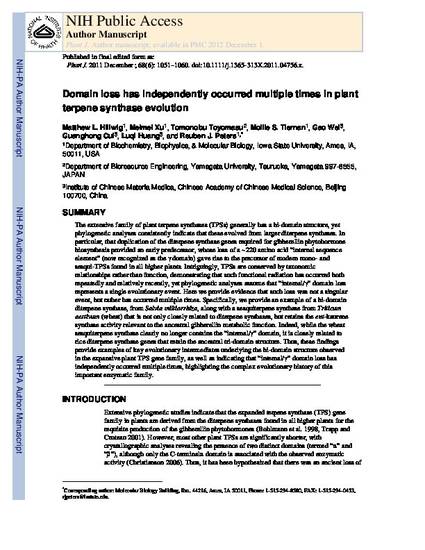
The extensive family of plant terpene synthases (TPSs) generally has a bi-domain structure, yet phylogenetic analyses consistently indicate that these evolved from larger diterpene synthases. In particular, that duplication of the diterpene synthase genes required for gibberellin phytohormone biosynthesis provided an early predecessor, whose loss of a ~220 amino acid “internal sequence element” (now recognized as the γ domain) gave rise to the precursor of modern mono- and sesqui-TPSs found in all higher plants. Intriguingly, TPSs are conserved by taxonomic relationships rather than function, demonstrating that such functional radiation has occurred both repeatedly and relatively recently, yet phylogenetic analyses assume that “internal/γ” domain loss represents a single evolutionary event. Here we provide evidence that such loss was not a singular event, but rather has occurred multiple times. Specifically, we provide an example of a bi-domain diterpene synthase, from Salvia miltiorrhiza, along with a sesquiterpene synthase from Triticum aestivum (wheat) that is not only closely related to diterpene synthases, but retains the ent-kaurene synthase activity relevant to the ancestral gibberellin metabolic function. Indeed, while the wheat sesquiterpene synthase clearly no longer contains the “internal/γ” domain, it is closely related to rice diterpene synthase genes that retain the ancestral tri-domain structure. Thus, these findings provide examples of key evolutionary intermediates underlying the bi-domain structure observed in the expansive plant TPS gene family, as well as indicating that “internal/γ” domain loss has independently occurred multiple times, highlighting the complex evolutionary history of this important enzymatic family.
Available at: http://works.bepress.com/reuben_peters/44/

This is the peer reviewed version of the following article: Hillwig, M. L., Xu, M., Toyomasu, T., Tiernan, M. S., Wei, G., Cui, G., Huang, L. and Peters, R. J. (2011), Domain loss has independently occurred multiple times in plant terpene synthase evolution. The Plant Journal, 68: 1051–1060 , which has been published in final form at doi:10.1111/j.1365-313X.2011.04756.x . This article may be used for non-commercial purposes in accordance With Wiley Terms and Conditions for self-archiving.